Hampshire
WINCHESTER
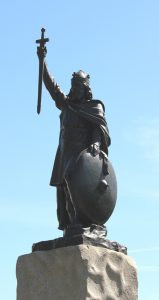
King Alfred's statue
For centuries before the Norman Conquest, Winchester was the capital of Wessex, and thus of England. London was the poor relation, facing disease and dereliction after the departure of the Roman legions. Generations of Saxon and Danish kings are buried here, including Egbert, Canute and Alfred the Great (849-901). The site of Alfred's grave is lost and so, as one author wrote, his dust is mingled with the soil we tread.
A statue of Alfred by Sir Hamo Thorneycroft was erected in the Broadway (SO23 9BE) in 1901 to mark the thousandth anniversary of his death. He stands defiantly with his sword held high, but its blade points downwards and his shield is resting on the ground, symbolising Alfred as a man of war by necessity rather than choice. The hilt of the sword forms a cross and, when a measure of peace with the Danes was finally achieved, he devoted himself to scholarship and founding monastic institutions to extend and promote the faith across his realm.
The Cathedral

Winchester Cathedral
The cathedral is one of the finest in England and the bishopric one of the most senior in the Anglican hierarchy. The roll call of events and people which have marked its history is impressive. There is a chantry chapel to William of Wykeham (1324-1404), twice Chancellor of the Realm, and one of the most powerful men in England. He extensively rebuilt the Norman cathedral and also founded New College, Oxford, and Winchester College. Queen Mary and Philip of Spain were married here in 1554 by Mary's henchman Bishop Stephen Gardiner. King William Rufus, son of the Conqueror, slain by an arrow in the New Forest, is buried here, as is Jane Austen. Charles Wesley's grandson, Samuel Sebastian Wesley, was cathedral organist from 1849 to 1864. Thomas Ken (1637-1711) was chaplain to the Bishop and once refused to admit Charles II's mistress, Nell Gwynne, to his house in the town.
Christianity came to Wessex in 635 when St Birinus founded his abbey at Dorchester, near Oxford, but the capital, both religious and political, soon shifted to Winchester and it was from here that Alfred ruled his Christian kingdom. The political importance of the city continued well into medieval times and its ecclesiastical prestige persists to this day.
In 984, Alphege became bishop and was much engaged in trying to mediate between the Saxon kingdoms and the Viking invaders. In 994, he was sent by King Ethelred to the Viking leader Olaf Tryggvesson, who was wintering at Southampton, persuading him to honour his former profession of Christianity. Ultimately, however, his efforts ended in failure and martyrdom. Appointed Archbishop of Canterbury in 1005, he was captured by a Danish raiding party and held for ransom, before suffering martyrdom at a drunken Viking feast in Greenwich.
The present cathedral was built in the years following the Norman Conquest, with extensive reconstruction in the fourteenth century. In the early twentieth century it was discovered that it had been built on a swamp, supported by a raft of beech trunks, and was in danger of collapse. A diver called William Walker spent six years descending blindly into the mire with sacks of concrete to shore it up. He has a well-deserved bust at the east end of the cathedral and a diving-suited statue near the shop outside.
Several of Winchester's bishops are worthy of particular mention. Stephen Gardiner took office in 1531 and supported Henry VIII's divorce from Catherine of Aragon. At one time he argued against the pope's authority over national churches but he was no friend of the Reformation. Deprived of office under Edward VI, he was reinstated by Mary and remained bishop until his death in 1555. He became Mary's chief agent in the persecution of Protestants and helped to send many to the flames of Smithfield, including his former archdeacon, John Philpot (1516-1555). Gardiner's chantry in the north aisle of the chancel reveals the grim "cadaver" style of the time, depicting the bishop as an emaciated corpse.
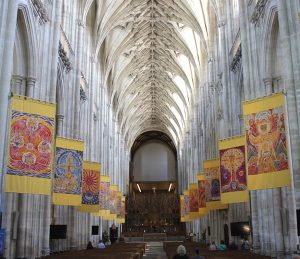
Winchester Cathedral interior
Two nineteenth century bishops who made significant contributions to Anglican churchmanship have impressive memorials. Charles Richard Sumner (1790-1874) was bishop for an astonishing forty-two years from 1827. He was a committed evangelical and his appointment showed that opposition by the Anglican hierarchy to the "enthusiasm" of the eighteenth century revival had now run its course. It was once again respectable to believe in the authority of the Bible and the doctrines of the Reformation. Sumner's memorial is in the retro-choir towards the east end. He was succeeded by Samuel Wilberforce (1805-1873), son of William, emancipator of the slaves. Although best remembered for his famous encounter with Thomas Henry Huxley over the question of evolution, Wilberforce was an eloquent preacher and efficient administrator. His religion combined the evangelicalism of his boyhood with a strong sense of churchmanship. During his time at Winchester he oversaw extensive changes in diocesan organisation. While actually buried at Lavington in Sussex, Wilberforce has an elaborate memorial in the south transept. His marble effigy is borne by winged angels and covered by an ornate neo-gothic canopy.
SOUTHAMPTON
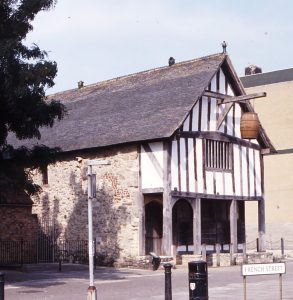
French Street, Southampton
Bombing raids by the Luftwaffe on two successive nights in 1940 severely damaged much of the ancient centre of the city. 630 people were killed and 4,000 houses destroyed, including the birthplace of Southampton's most famous son, Isaac Watts (1674-1748), whose father, a clothier and church deacon, suffered imprisonment under the acts of Charles II against non-conformists. Watts was born at 21 French Street, not far from the Town Quay. An impression of the street at that time can be gained from the one ancient building that survived, 58 French St, a former medieval wine merchant's house - now a museum (SO14 2AT). Bugle Street, running parallel to French Street, fared slightly better and shows something of the character of old Southampton. It has several old buildings, including the Tudor House Museum, where a photograph of Watts' birthplace and a watercolour by W.M. Cooper can be seen.
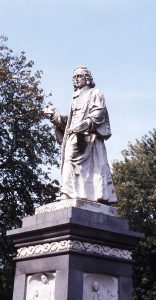
Isaac Watts statue
While remembered mainly for his hymns, Watts was also a preacher, poet, educationalist, pamphleteer and man of science. Southampton is proud of his links with the city and he is commemorated in several places. The Independent church in Above Bar, where he was brought up, was also destroyed in the war; the site is marked by a plaque on the back of the shops in Vincent's Walk, close to the Bargate. There is also an Isaac Watts Memorial Church at the junction of Winchester Road and Luccombe Road, in the Shirley district of the city.
Close to the Civic Centre, Watts Park (SO14 7FQ) has a statue by R.C. Lucas, unveiled by the Earl of Shaftesbury in 1861. Surrounded by chestnut trees and beds of roses, three panels at the base show scenes from Watts' life, while the fourth extols his virtues as An example of the talents of a large and liberal mind, wholly devoted to promotion of piety, virtue and literature. It ends with a verse from one of his hymns:
From all that dwell below the skies
Let the Creator's praise arise
Let the Redeemer's name be sung
Through every land by every tongue
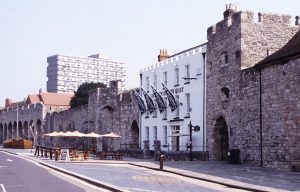
West Quay Southampton
Despite the ravages of wartime bombing, a large section of Southampton's ancient city wall is still intact along the Western Esplanade, facing modern hotels and the multi-storey car parks of the West Quay Shopping Centre (SO14 2AY). In the past, ships could pull up against the quay here, a few feet from the old walls, and today large ship models and profiles have been set into the pavement to convey an impression of the former quayside. At the ancient Westgate, grooves for the portcullis can still be seen and through this arch marched some of Henry V's bowmen on their way to Agincourt.
It was from here too that the Pilgrim Fathers loaded their goods and chattels into the Mayflower and the Speedwell and set off for the New World on August 15th 1620. Despite stops for emergency repairs at Dartmouth and Plymouth, Southampton claims the honour of being the pilgrims' port of departure. Their memorial, unveiled by the American ambassador in 1913, is a plain square column of portland stone by the Town Quay. On top is a beacon, covered by a dome supported on Grecian columns and surmounted by a model of the historic vessel. The main inscription records that many of the Pilgrims derived from a separatist congregation in Babworth, Nottinghamshire, which moved to Scrooby in 1606, to Amsterdam in 1608 and to Leyden in 1609. In recent years, several bronze plaques to individuals have been added to the column by the families of their descendants. One plaque on the west side commemorates William Brewster, the acknowledged leader of the group. The open space immediately opposite the memorial is called Mayflower Park.
DUMMER

Whitefield's pulpit
For a few weeks in 1736, the flint walls and wooden beams of the little church (RG25 2AY) echoed to the melodious voice of George Whitefield, which was envied by the greatest actors of the day. The pulpit he preached from was already 350 years old when he arrived as curate to Benjamin Kinchin and is still in use. Whitefield's open air preaching in Bristol and London was to sound the start of the revival which profoundly influenced the social histories of both England and America. Despite his short stay, it was here that Whitefield made one of his most far-reaching decisions - to cross the Atlantic and pay his first visit to the newly founded colony of Georgia.
HURSLEY
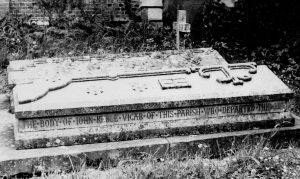
Grave of John Keble
John Keble (1792-1866) spent the last thirty years of his life as vicar of All Saints Church (SO21 2JB), remote from the controversies of the Oxford Movement, which he had helped to provoke. The present church, looking older than it is, was financed by Keble himself with the proceeds from his popular poem, The Christian Year. There are memorials to members of the Cromwell family, including Richard Cromwell who served briefly as Lord Protector of England after the death of his father, and was buried here in 1712. Keble and his wife Charlotte lie in the south west corner of the churchyard. On top of his granite tomb are carved a Bible and a chalice, reminding us that in Keble's life doctrine and ritual blended together in a form that some found unacceptable, but nevertheless symbolised his sincere and humble piety.
ISLE OF WIGHT
Arreton
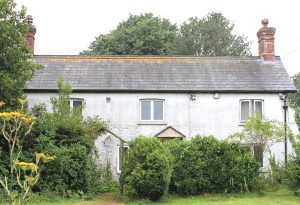
The Dairyman's Daughter's cottage
In 1797, the young Legh Richmond (1772-1827) arrived as curate of St Mary's, Brading, but did not experience true conversion until he read William Wilberforce's Practical Christianity two years later. Richmond was a diligent pastor and recorded his encounters with the ordinary folk of his parish in a series of tracts called the Annals of the Poor, a line taken from Gray's Elegy in a Country Churchyard. The most famous of these was The Dairyman's Daughter, which was translated into six languages and sold two million copies.
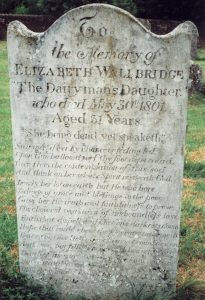
Grave of Elizabeth Wallbridge
The subject of the story was Elizabeth Wallbridge, daughter of a dairyman whose slate-roofed cottage can still be seen at Hale Common on the road to Sandown (PO36 0LT). She had struck up a friendship with Richmond after writing him a letter of gratitude for conducting the funeral of her sister. Richmond recounts in poignant prose the faithfulness and piety of Elizabeth as she succumbs to the ravages of tuberculosis and eventually dies herself. The story appealed to the moral sentiments of the time, and was often given to servant girls by their mistresses as appropriate and uplifting reading material.
Elizabeth died in 1801 at the age of thirty-one and is buried beside her sister in the churchyard on the north side of St George's, Arreton (PO30 3AA). Her headstone has a lengthy epitaph beginning:
Stranger, if e'er by chance or feeling led
Upon this hallowed turf thy footsteps tread
Turn from the contemplation of this sod
And think on her whose spirit rests with God.
Brading
The Isle of Wight was evangelised in the seventh century by the energetic Wilfrid of York (634-709). Wilfrid at the time had fallen out with his fellow clerics in Northumbria and was facing a period of exile in Sussex. Not one to let time pass him by, he travelled to the island and is said to have preached his first sermon at Brading.
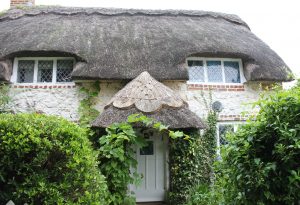
Jane Squibb's cottage
The village was the scene of another moral tale by Legh Richmond, curate of St Mary's church. This time the subject was Jane Squibb, the Young Cottager, who attended Richmond's Bible class. One exercise he set was for the children to read the inscriptions on the headstones in the churchyard to see what insights they could be gain. Discerning a greater spiritual awareness in Jane, he tells her story as she also falls victim to the scourge of tuberculosis at the tragically early age of fifteen. She is buried close to the east wall of the church, the headstone naming her simply as Little Jane. There is a memorial brass to Richmond on the south wall of the church, recording his ministry as curate-in-charge from 1797 to 1805 and the wide circulation of his writings.
Jane Squibb's home was a thatched cottage in The Mall, Brading's former main street (PO36 0DE). Described by Richmond as a squalid hovel, modern estate agents would no doubt depict it in rather more glowing terms. It can be seen today, with stone walls, neatly trimmed thatch and a picture postcard cottage garden.
Ryde

William Carey's house
In Castle Street, just behind the Esplanade, is the little house where William Carey (1761-1834) spent his last days before leaving his homeland forever.
The pioneer missionary had left his home in Leicester with his eldest son to join a ship for India, but confusion over money with the newly formed Baptist Missionary Society meant that the fleet sailed without him. However, the delay enabled him to return home and persuade his reluctant wife and their other children to join him. They all sailed a few weeks later in June 1793. Dorothy Carey had never felt her husband's call to missionary work and her time in India was marred by severe physical and mental ill health.
The 2-storey pebble-dashed house is privately owned and carries a plaque to Carey.
Brighstone

The Three Bishops pub
The church of St Mary the Virgin was built around 1190. Inside a memorial plaque commemorates three men who were rectors here and went on to achieve high office in the Church of England. The saintly Thomas Ken (1637-1711) came in 1667 and stayed for two years. The sanctuary pavement is a memorial to him and the church's register has entries in his handwriting. He later became Bishop of Bath and Wells and is remembered for his hymns, including Praise God from whom all blessings flow.
Samuel Wilberforce (1805-1873) was rector from 1830 to 1840. His father William, in his closing years, would spend part of the year at the rectory here, and the rest with his other son Robert at East Farleigh. Samuel went on to become Bishop of Oxford and subsequently Bishop of Winchester. The third man was George Moberly, rector from 1867 to1869. He had been headmaster of Winchester College for thirty years and later became Bishop of Salisbury.
In recognising this distinction, the village pub is named The Three Bishops, but the pub sign shows three figures from an earlier period, medieval perhaps or even biblical (PO30 4AH).


